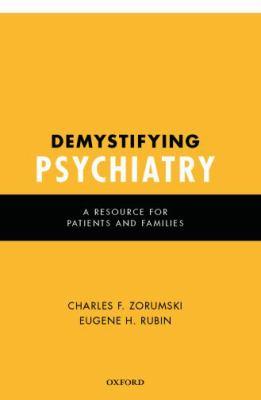
Today I have the honor of interviewing Eugene (Gene) and Charles (Church) Zorumski, authors of “Demystifying Psychiatry: A Resource for Patients and Families.” It is a fascinating and comprehensive resource to explain one of the most misunderstood sciences of our time.
Question: In your book, you chart the various trends of psychiatry. In your view what are the most substantial trends and why?
Answer: Thank you for asking us about our thoughts concerning the most substantial trends in psychiatry and about why we are optimistic about the future of psychiatry.
We believe that three of the most substantial trends in psychiatry today are:
- Increasing collaboration between primary care and mental health teams in the delivery of psychiatric care
- Increasing use of and greater availability of evidence-based treatments
- Increasing translation of neuroscience research into psychiatric diagnosis and treatment. By that, we mean these three things:
A) We believe that the delivery of psychiatric care will increasingly require close collaboration between primary care medical teams and mental health teams. In this model, the psychiatrist would act in a consultative role to the primary healthcare team. The primary care physician (PCP) and staff would learn to recognize and treat patients with less complicated psychiatric illnesses. A non-physician member of the primary care team could be specifically trained to serve in a case manager-type capacity and help coordinate the collaboration between the PCP and the psychiatrist.
In patients with more difficult-to-treat illnesses such as those involving psychosis, active manic symptoms, or refractory depression, the psychiatrist would take a more primary role in care delivery and lead the healthcare team with the help of collaboration from the PCP. The mental health team would utilize the skills of mental health professionals with various backgrounds in addition to the psychiatrist.
The impetus for this model of care is based on several trends discussed in the book. These include the likelihood that there will continue to be a significant shortage in the number of psychiatrists; increased use of evidence-based treatments, some of which can be effectively initiated by the PCP’s team; increased recognition of the impact of psychiatric illnesses on the outcome of concurrent medical conditions (such as heart disease and diabetes) and on the health care economy; and continued decrease in the stigma associated with psychiatric illnesses as parity in insurance coverage is implemented.
Psychiatric disorders are major contributors to disability in western economies and are associated with substantial mortality, particularly when addictive disorders such as alcoholism and nicotine dependence are taken into account. We see psychiatry as playing a key role in helping to diminish these drivers of health care costs.
B) Choice of psychiatric treatment will be increasingly based on data demonstrating that the treatments are effective. Results defining best clinical practices are rapidly accumulating. Psychiatrists are required to participate in continuing medical education, and these activities increasingly emphasize best practices based on clinical research.
It is essential that continuing education of physicians emphasizes unbiased information that is independent of marketing by the pharmaceutical and medical device industries. The trend to eliminate financial conflicts of interest is important.
New treatments will likely emphasize combinations of psychological therapies, life style approaches, cognitive rehabilitative strategies, and biological approaches. The misguided belief that cures can come from a simple pill will be replaced by recognition that better understanding of the full spectrum of brain sciences and the role of environment on brain function is necessary in order to develop more effective treatments.
C) Advances in neuroscience research are exciting and important. We would like to highlight two areas of progress that will have significant influence on psychiatry.
- Knowledge from scientific research is leading to the development of strategies for combining different treatment modalities to treat specific disorders. For instance, we are now beginning to consider how to pair medications that augment learning with various behavioral therapies. Such an approach has implications for the treatment of a variety of anxiety disorders, including phobias, panic disorder, and post-traumatic stress disorder, and may find utility in other disorders. There is increasing recognition that learning and cognitive deficits accompany major psychiatric disorders, and these deficits are now becoming targets for therapeutic and rehabilitative interventions.
- Significant progress is being made in understanding how brain systems coordinate activity to generate human thinking, emotions, and motivation, as well as the way such systems malfunction to produce psychiatric disorders. Over the long term, such understanding will allow the development of treatments that target brain mechanisms underlying psychiatric symptoms and disorders. These treatments could potentially stop disorders from advancing or even prevent disorders from developing. Prevention requires the ability to predict who is going to develop an illness before symptoms appear (pre-clinical diagnosis). We would emphasize the tremendous progress being made in pre-clinical diagnosis of Alzheimer’s disease, and this serves as a model for what may be possible in primary psychiatric disorders. Over the next several decades, we envision similar advances involving anxiety and addictive disorders. Eventually, these approaches should lead to increasingly specific interventions for psychotic disorders, mood disorders, and personality disorders.
Question: You are optimistic about the future of psychiatry. Can you give me a few reasons why?
Answer: Why are we optimistic about psychiatry’s future?
- In the near term, we believe that awareness about the widespread prevalence of psychiatric illnesses and the need to improve mental healthcare delivery will grow, and this will lead to better methods of delivering psychiatric care.
- In the long term, several research approaches are beginning to produce results that increase the likelihood for major treatment advances over the next several decades. As explained in our book, new brain imaging methods are enhancing our ability to map the specific brain systems responsible for emotion, motivation, and cognition. The study of genes, environment, and the dramatic ways that environment can influence gene expression is providing us with tools to understand how psychiatric disorders result from the malfunctioning of specific brain systems.
- Advances in molecular sciences are giving us tools that may aid in correcting “broken” brain systems. It is likely that brain systems are amenable to repair because brain connections and brain cells are much more “plastic” than originally believed. Certain treatments can increase the number of nerve cells in specific regions of the brain and influence how brain cells connect to each other and communicate with each other. These advances suggest that progress is highly probable over the next several decades. The pace at which neuroimaging and cellular and molecular neuroscience is advancing is dramatic and bodes extremely well for the future of psychiatry.
- We hope this gives you a flavor of our thinking. In “Demystifying Psychiatry,” we try to help the reader understand practical issues about psychiatry and psychiatric care as well as how to navigate today’s psychiatric system. In addition, we try to help the reader understand future trends and reasons for optimism.
* Click here to subscribe to Beyond Blue and click here to follow Therese on Twitter and click here to join Group Beyond Blue, a depression support group. Now stop clicking.

